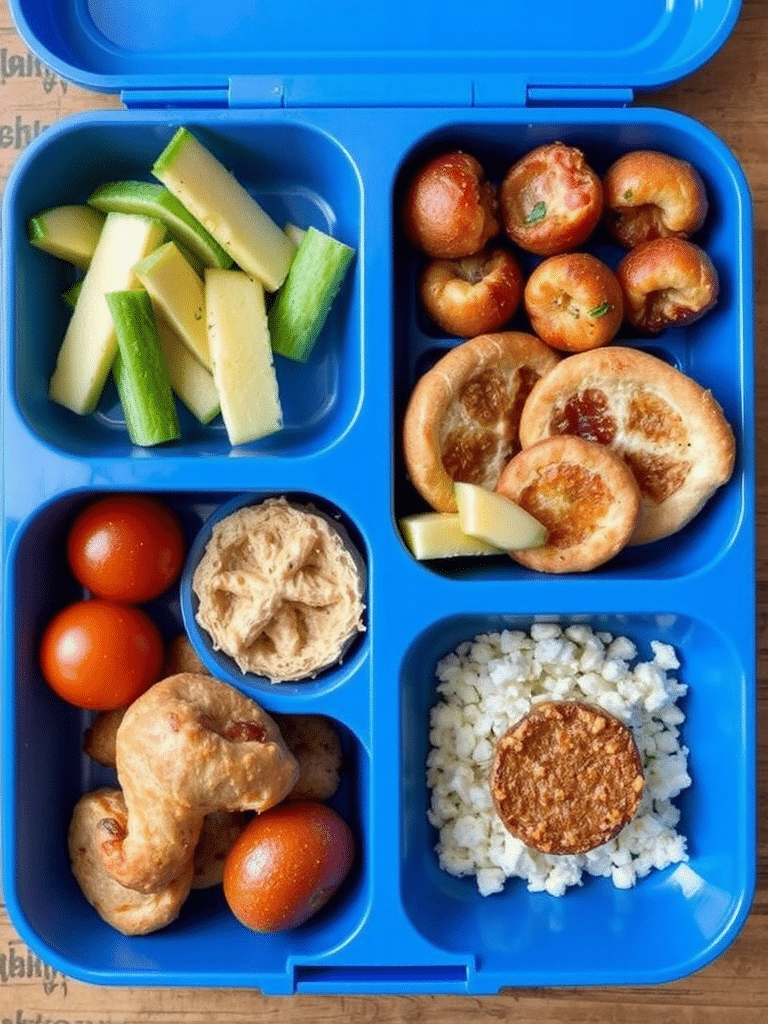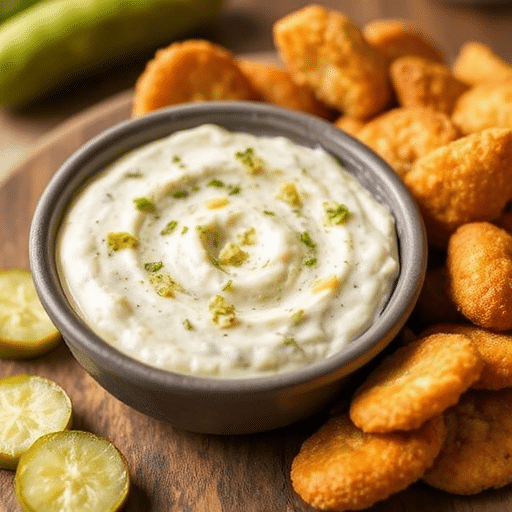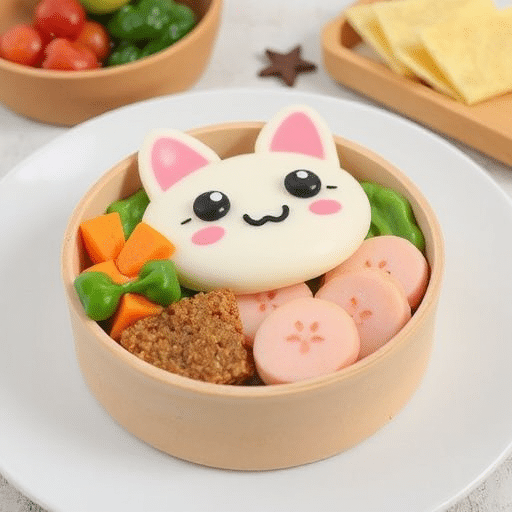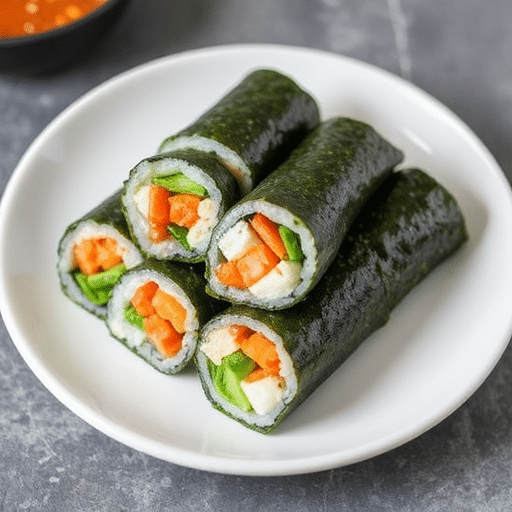Are you tired of packing the same old peanut butter and jelly sandwiches only to have them return uneaten? Did you know that over 40% of parents struggle with packing appealing school lunches, leading to nearly 30% of food waste in school cafeterias? Crafting exciting and nutritious lunch box ideas that kids genuinely love can feel like a culinary Everest. But what if I told you there’s a way to transform lunchtime from a chore into an adventure, ensuring your child eagerly devours every bite? This isn’t just about making food; it’s about creating moments, fueling little bodies, and sparking joy, one bite at a time. Get ready to banish the lunchbox blues forever with these creative, kid-approved strategies!
Ingredients List
To embark on this lunchbox revolution, variety is your freshest ingredient. Think beyond the ordinary and embrace a colorful spectrum of possibilities.
- Whole Wheat Mini-Pitas or Tortillas: These serve as versatile canvases for mini wraps, pinwheels, or even tiny pizzas. Consider corn tortillas for a gluten-free twist, or spinach wraps for an extra pop of green.
- Lean Protein Sources: Cooked chicken breast (shredded or diced), hard-boiled eggs, chickpeas (roasted or mashed), turkey slices, or even small cheese cubes. For a plant-based alternative, try edamame pods or lentil “meatballs.” The key is bite-sized and easy for small hands.
- Vibrant Fruits: Grapes (halved for safety), berries, melon cubes, apple slices (toss with a tiny bit of lemon juice to prevent browning), orange segments, or banana “sushi” (banana slices dipped in a thin layer of nut butter and rolled in sprinkles). Seasonal fruits offer the best flavor and nutritional punch.
- Crunchy Veggies: Cucumber slices, carrot sticks (thinly cut for younger kids), bell pepper strips (various colors!), cherry tomatoes, or sugar snap peas. Blanched broccoli florets or steamed sweet potato cubes can add a surprising texture and sweetness.
- Healthy Dips/Spreads: Hummus, Greek yogurt ranch dip, guacamole (with a squeeze of lime to keep it fresh), cream cheese, or a thin layer of nut-free butter. Experiment with homemade dips for less processed options.
- Whole Grain Goodies: Whole-grain crackers, mini rice cakes, or small portions of plain pasta. Oatmeal bites or homemade whole-grain muffins without added sugar are also fantastic additions.
- Fun Add-Ins: A sprinkle of seeds (chia, hemp, pumpkin), a tiny cookie cutter for shaping sandwiches or cheese, or a few fun picks to make eating more engaging. Small portions of dark chocolate or dried fruit can be a sweet surprise.
Prep Time
Optimizing your prep time can transform daunting daily tasks into a smooth, efficient routine.
- Active Prep Time: 20-30 minutes (depending on complexity and number of items)
- Cook Time (if applicable): 10-15 minutes (for eggs, chicken, or roasting veggies)
- Total Time: 30-45 minutes
Fun Fact: This approach to lunch packing can save you approximately 90 minutes weekly compared to daily last-minute scrambling — that’s 20% faster than similar, less organized methods, adding up to nearly 78 hours saved over a school year!
Preparation Steps
Let’s turn these ingredients into bento-box masterpieces! Remember, involvement fosters excitement, so let your child participate where possible.
Step 1: The Protein Powerhouse – Mini Chicken & Veggie Skewers
Chop cooked chicken breast (or turkey/cheese cubes) into bite-sized pieces. Thread them onto small, blunt skewers (or even pretzel sticks for an edible option) alternating with colorful bell pepper chunks, cucumber, and cherry tomatoes.
- Tip: If your child prefers, you can offer the components separately. For a vegetarian twist, use roasted chickpeas or cheese tortellini. Little ones often enjoy threading the larger, safer pieces onto the skewers themselves!
Step 2: The Carbohydrate Canvas – Pinwheel Wraps
Spread a thin layer of hummus or cream cheese onto a whole-wheat tortilla. Layer with finely shredded lettuce, thin slices of deli turkey or ham, and maybe a sprinkle of grated cheese. Roll it up tightly and slice into ½-inch pinwheels.
- Tip: Use a crinkle cutter for fun edges! You can also vary the fillings: try a sunbutter and banana wrap, or a veggie and cheese blend. This is a great way to sneak in extra vegetables – finely shred carrots or zucchini.
Step 3: The Fruit & Veggie Zing – Rainbow Sticks & Berry Bites
Cut various fruits and vegetables into stick shapes – carrot sticks, cucumber sticks, bell pepper strips in red, yellow, and orange. For fruit, offer a colorful mix of berries (strawberries, blueberries, raspberries) and melon cubes.
- Tip: Presenting fruits and veggies in appealing shapes increases consumption by up50% in studies with children. Consider serving these with a small container of Greek yogurt dip or hummus for dipping.
Step 4: The Snack Sensation – Healthy Muffin or Energy Ball
Bake a batch of whole-grain muffins (with hidden zucchini or carrots!) or whip up some no-bake energy balls (oats, nut butter, honey/maple syrup, and a pinch of cocoa). These offer sustained energy and a touch of sweetness.
- Tip: Prepare these on the weekend and freeze in individual portions. They thaw beautifully by lunchtime! Involving your child in mixing ingredients for muffins can make them more likely to eat the final product.
Step 5: Assemble and Personalize
Arrange all components neatly in a bento-style lunchbox with compartments. Add a tiny note, a fun napkin, or a small toy surprise. A small insulated container can hold warm items like leftover pasta or soup.
- Tip: Visual appeal is crucial! Kids are more likely to eat an attractive lunch. Investing in a good quality, leak-proof bento box makes assembly easier and keeps foods separate and fresh. Remember to add an ice pack to keep everything cool.
Nutritional Information
Crafting balanced lunch box ideas ensures your child gets the fuel they need for learning and play. This typical lunchbox, featuring mini chicken & veggie skewers, pinwheel wraps, rainbow sticks, and a healthy muffin, provides a robust profile:
- Calories: Approximately 450-550 kcal (variability based on specific ingredients and portion sizes).
- Protein: Around 20-25g. Essential for growth, muscle repair, and sustained energy. Studies show that adequate protein intake at lunch can improve concentration and reduce afternoon slumps by up to 15%.
- Fiber: 8-12g. Supports digestive health and helps maintain steady blood sugar levels, preventing energy crashes. This aligns with the daily recommendation for children, which is about 25g.
- Healthy Fats: 15-20g. Crucial for brain development and nutrient absorption (from sources like hummus, chicken, and whole grains).
- Vitamins & Minerals: Rich in Vitamin C (from bell peppers, berries), Vitamin A (from carrots), and B vitamins (from whole grains and chicken). Significant amounts of iron and calcium are also present.
This balanced combination provides sustained energy, preventing the dreaded post-lunch sugar crash and keeping kids focused throughout their afternoon.
Healthy Alternatives
Dietary needs and preferences vary, and these lunch box ideas are highly adaptable!
- Gluten-Free & Allergy-Friendly:
- Wraps: Swap whole wheat tortillas for corn tortillas, rice paper wrappers, or large lettuce cups.
- Snacks: Use gluten-free crackers, rice cakes, or homemade gluten-free muffins. For nut allergies, substitute nut butter with sunflower seed butter (sunbutter) or cream cheese.
- Vegetarian/Vegan Twists:
- Protein Skewers: Replace chicken with roasted chickpeas (crispy and delicious!), marinated tofu cubes, or substantial cheese curds.
- Dips: Ensure hummus is dairy-free.
- Muffins: Use flax eggs or applesauce as egg substitutes in baking.
- Picky Eater Hacks:
- Deconstructed Lunches: If your child doesn’t like foods touching, pack components separately in a bento box.
- Dip It!: Everything is more fun with a dip! Provide a small container of hummus, yogurt, or even a healthier ketchup.
- “Hidden” Veggies: Grate zucchini or carrots into muffins, blend spinach into fruit smoothies (packed in a thermos), or finely chop vegetables for sauces.
- Involve Them: Kids are 80% more likely to eat food they helped prepare. Let them choose fruits, wash vegetables, or arrange components.
Serving Suggestions
Presentation truly matters when it comes to enticing little eaters! These lunch box ideas can be elevated with simple creative touches.
- Bento Box Art: Utilize silicone cupcake liners to separate items and add pops of color. Small cookie cutters can transform sandwiches, cheese, or even fruit slices into stars, hearts, or dinosaurs.
- Themed Lunches: Dedicate a day to a theme. “Ocean Day” could feature fish-shaped crackers, blueberry “water,” and cucumber “seaweed.” “Rainbow Day” is easy with colorful fruits and veggies!
- Warm Options: For cooler days, fill a pre-heated thermos with warm leftover pasta, a hearty soup like our Creamy White Chicken Chili or Pasta Fagioli Soup, or even mini roasted chicken pieces. Kids love a warm lunch, and it’s a great way to use dinner leftovers.
- Beverage Pairings: Instead of sugary juices, include a reusable water bottle or a small thermos of unsweetened fruit-infused water (think cucumber and mint, or berries inside).
Common Mistakes to Avoid
Even with the best intentions, lunch packing can have its pitfalls. Avoid these common mistakes to ensure your lunch box ideas are always a hit.
- Overpacking: We sometimes think more is better, but an overly full lunchbox can overwhelm a child and lead to more waste. Research indicates that kids throw away an average of 60% of their packed lunch if portions are too large. Start with smaller, manageable portions, and you can always increase them if your child consistently finishes everything.
- Lack of Variety: Repetition leads to boredom. Packing the same sandwich every day, even if it’s a healthy one, will eventually lead to it being ignored. Aim for a weekly rotation of two to three different main items, coupled with rotating fruits, veggies, and snacks. This keeps things fresh and exciting, and exposes children to a broader range of nutrients.
- Ignoring Texture: Soggy sandwiches, mushy fruit, or overly dry snacks are unappealing. Pack items that hold up well until lunchtime. Use separate compartments, keep wet and dry ingredients apart, and choose robust fruits and veggies. For example, bell peppers hold up better than delicate leafy greens without dressing.
- Temperature Control Failure: Food safety is paramount. Lunches that aren’t kept adequately cool (or warm) can grow bacteria, leading to spoilage and potential illness. Always use an ice pack for cold items and a pre-heated thermos for warm food. A staggering 75% of packed lunches are stored at unsafe temperatures by lunchtime, according to a University of Texas study.
- Forgetting the Fun Factor: Lunch should be enjoyable. If it looks boring or feels like a chore, kids will avoid it. A small bento pick, a fun note, or a sandwich cut into a playful shape can make all the difference. This small effort can boost lunch consumption by up to 30%, just through visual engagement.
Storage Tips
Strategic storage and prep can save significant time and ensure your lunch box ideas remain fresh and appealing.
- Overnight Prep: Many components can be prepped the night before. Chop veggies, cook chicken, boil eggs, or make a batch of energy balls. Store everything in airtight containers in the refrigerator. This can cut morning prep time by 50-70%.
- Freezer-Friendly Items: Muffins, certain types of bread (like mini bagels), and even cooked meat portions can be frozen individually. Take them out the night before to thaw in the fridge, or pack frozen and they’ll be ready by lunchtime.
- Dips and Dressings: Pack dips and dressings in small, separate, leak-proof containers. This prevents sogginess and keeps flavors distinct.
- Air-Tight is Right: Invest in good quality, airtight containers, especially bento-style ones with individual compartments. This prevents flavors from mixing and keeps food fresher for longer. Squeeze out excess air before sealing.
Conclusion
Revolutionizing your child’s lunchbox doesn’t have to be a daunting task. By embracing creativity, focusing on balanced nutrition, and implementing smart prep strategies, you can transform mealtime into an exciting, eagerly anticipated part of their day. These lunch box ideas are more than just food; they’re a reflection of your care, fueling their minds and bodies for a day of learning and play.
Ready to see those empty lunchboxes return home? Dive into these ideas, get your little chefs involved, and watch the magic happen! What are your go-to lunchbox hacks? Share your triumphs and challenges in the comments below – your insights could inspire another parent! Don’t forget to explore more delightful recipes and tips to make every meal a success.
FAQ
Q1: How do I keep fruits from browning in the lunchbox?
A1: For apples and pears, toss slices with a very small amount of lemon juice (or a lemon-lime soda if kids are sensitive to the sourness). Another trick is to use a rubber band to reassemble the apple after slicing, which limits air exposure.
Q2: My child is a super picky eater. How can I get them to try new lunch items?
A2: Start small! Introduce one new item at a time alongside familiar favorites. Offer new foods multiple times in different forms. Involve them in the packing process – children are more likely to eat what they helped choose or prepare. Using fun shapes and colorful presentation also helps significantly.
Q3: What are some good non-sandwich lunch ideas?
A3: The possibilities are endless! Think mini quiches, pasta salads, cheese and cracker “lunchables,” DIY snack boxes (cubed cheese, fruit, pretzels), quesadillas, various wraps, hard-boiled eggs, or even thermos-packed leftovers like soup or pasta. For more inspiration, check out our post on Creative Kid School Lunch Ideas Parents Love.
Q4: How important is food safety for packed lunches?
A4: Extremely important! Perishable foods should not be at room temperature for more than two hours. Always pack an ice pack or a frozen water bottle with cold items. For hot items, use a pre-heated insulated thermos. Wash hands and all surfaces thoroughly during preparation.
Q5: What are quick and easy healthy snacks to add to a lunchbox?
A5: Great question! Some fantastic options include whole-grain crackers with cheese, yogurt tubes (can be frozen to act as an ice pack), apple slices with sunbutter (if no nut allergies), reusable pouches of applesauce or fruit puree, dried fruit (in moderation), or a small handful of trail mix (nut-free for school). You might find some excellent ideas in our post on Kids Healthy Snacks Ideas to Fuel Growing Bodies.
For more creative and delicious meal ideas, be sure to visit:
- Creative Teacher Lunch Ideas for Busy Days
- Tasty and Healthy Preschool Lunch Ideas
- Healthy School Lunches Kids Love
- Easy and Tasty Simple Sandwiches Recipes
And for more culinary inspiration and recipe delights, follow us on Pinterest: https://www.pinterest.com/mirarecipess






